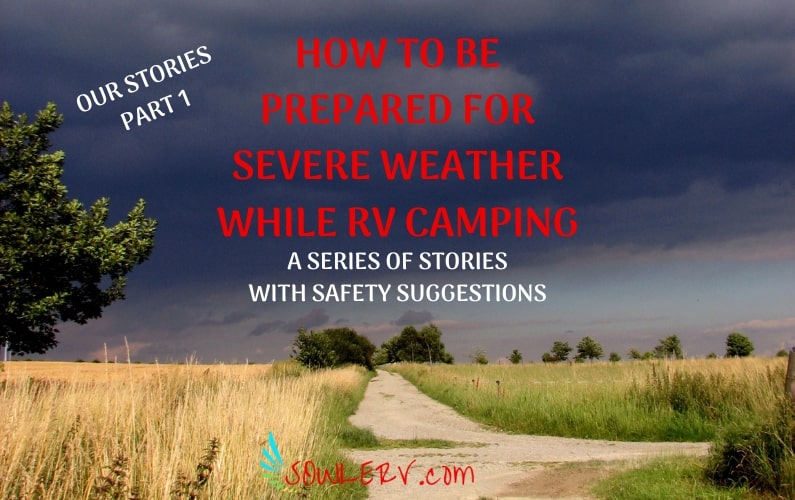

Written by SOWLE RV
March 21, 2019

RV Camping Severe Weather Awareness
~Our Stories Part 1~
Severe Weather Alerts and Knowledge
National Weather Service Awareness and Preparedness
Every state in the U.S. has weather safety events for the public to gain Severe Weather knowledge as part of the NWS National Seasonal Safety Campaign: Preparing the public for hazardous weather year-round. Click HERE to find your states’ events.
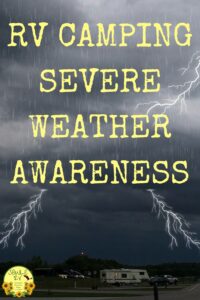
Have the Discussion
When you arrive at an RV Park or Campground, the first thing you should do is inquire about their inclement weather emergency plan if they have one in place. If they don’t, it is your responsibility to have one for your family.
The most important thing you can do to protect your family in case of an emergency is to sit down with them and discuss these following things and have a plan of action BEFORE Severe Weather is heading your way!
Emergency Alerts
Decide how will you get alerts of inclement weather. A NOAA Weather Radio is a great way to receive severe weather alerts. Make sure you have batteries for it too!
Here is the link for the NOAA Weather Radio we use:
Know Your Location
When RV Camping, many times you’re not in an area that you are familiar with. Know your exact location on a map including the zip code, the campground name, and your specific campsite number. You also need to know the county you are in and surrounding counties in case warnings are issued.
Additionally, know what kind of weather your location can get. Also having the address of the nearest hospital with an Emergency Department is a good idea.
Shelter and Emergency Evacuation Route
Where will you go in a weather emergency?
Where is the safest and closest place? Remember to consider travel time when you make your plan for severe weather because of how quickly it can strike. What is the safest route? What if there is high water/flooding?
If members of the family are in different areas, where is your exact meeting place?
Also, consider the construction of the building you plan to use as shelter and is there enough space for all the camping folks in that location?
Having the answers to these questions will make plans easier and will help you determine how much time you have to get to your safe location in the event of severe weather.
Communication
How will you communicate with family? If family members are in different locations, what is your plan? What if cell towers are down in your area? Keep in mind that storms can sometimes affect cell phone reception.
Emergency Kits
Always be sure you have a First Aid Kit on hand for people and animals. You just never know when you will need supplies and you don’t want to be without them.
Also, make sure your First Aid Kit is always kept in the same location for every trip, ensuring everyone knows exactly where it is at all times. Have an emergency information list available as well. This list should include any known allergies, medications the person is taking, and an emergency contact list.
Family Safety Bag
Pack a Family Safety Bag containing anything you may need in the event of severe weather and have it in a known location to all.
Your Family Safety Bag should include the following:
Extra clothing
Medications
Flashlight with batteries
Blanket
NOAA Weather Radio with batteries
Cell Phone Charger
Food (at least a snack as you never know how long you may be at the shelter)
Water (at least have a bottle per person)
Battery powered fan with batteries (this is the one we use):
First Aid Kit for people
First Aid Kit for Pets
Important documents you may need
Other specific supplies needed for each family member
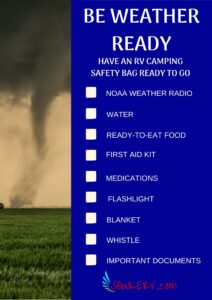
NOAA Weather Radio
As I mentioned earlier, having a NOAA Weather Radio is a perfect way to keep up with the latest weather updates. Your NOAA Weather Radio will deliver Hazardous Weather Outlooks which describes potential hazardous weather for the next 7 days.
The NOAA forecast is helpful when planning an RV Camping Trip and will also help you know when you need to seek shelter if severe weather is coming. It will also notify you if there is a need for Trained Storm Spotters. If you would like more information on how to become a trained Storm Spotter for your area, click HERE.
SEVERE WEATHER ALERTS
Thunderstorms, Floods, and Tornadoes can happen fast in the Midwest.
Thunderstorms can bring deadly lightning, hailstones, damaging winds, and flooding.
Tornadoes can bring winds over 200MPH creating deadly flying debris, mobile homes and RVs to be blown over or completely destroyed, and buildings to be destroyed.
It is so important to understand the difference between Severe Weather Alerts such as an Advisory, a Watch and a Warning for Thunderstorms, Flooding, and Tornadoes.
DESCRIPTIONS OF WEATHER ALERTS BY THE NATIONAL WEATHER SERVICE
ADVISORY-An Advisory is issued when the weather has a good chance of happening, but typically for less severe weather conditions.
WATCH-A Watch is issued when there is a chance this condition may happen and usually covers a larger area for a longer period of time.
WARNING-A Warning is issued when the weather is either occurring or likely to occur soon and are usually issued for a smaller area for a shorter period of time.
Understanding Severe Thunderstorm Risk Categories listed by the National Weather Service
Thunderstorms-No severe thunderstorms expected. Lightning/Flooding threats exist with ALL thunderstorms.
Marginal Risk-Isolated severe thunderstorms are possible. Limited in duration and/or coverage and/or intensity.
Slight Risk-Scattered severe storms possible. Short-lived and/or not widespread, isolated intense storms possible.
Enhanced Risk-Numerous severe storms possible More persistent and/or widespread isolate intense storms possible.
Moderate Risk-Widespread severe storms likely. Long-lived, widespread, and intense.
High Risk-Widespread severe storms expected. Long-lived, very widespread, and particularly intense.
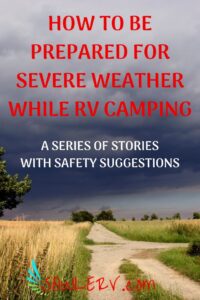
National Weather Service Definitions
The National Weather Service Defines these hazardous weather statements that are typically issued in the Midwest as follows:
Wind Alerts
Wind Advisory
A Wind Advisory is issued when the following conditions are EXPECTED:
-sustained winds of 31-39mph for one hour or more
OR
-wind gusts of 46-57mph for any duration
High Wind Watch
A High Wind Watch is issued when the following conditions are POSSIBLE:
-sustained winds of 40MPH or higher for one hour or more
OR
-wind gusts of 58mph or high for ant duration
High Wind Warning
A High Wind Warning is issued when the following conditions are EXPECTED:
-sustained winds of 40mph or higher for one hour or more
OR
-wind gusts of 58mph or higher for any duration
*Trees and powerlines can be blown down in these conditions.
Extreme Wind Warning
An Extreme Wind Warning is issued when surface winds are 115MPH (or greater) and NOT associated with a Tornado or if sustained hurricane winds are expected to occur within one hour.
Thunderstorm Alerts
Severe Thunderstorm Watch
A Severe Thunderstorm Watch is issued when severe thunderstorms are POSSIBLE in and near the watch area.
-Winds of 58mph or higher
AND/OR
-Hail 1” in diameter or larger
Severe Thunderstorm Warning
A Severe Thunderstorm Warning is issued when severe thunderstorms are IMMINENT (about to happen) or ARE OCCURRING in the warning area.
-Winds of 58MPH or higher
AND/OR
-Hail 1” in diameter or larger
Tornado Alerts
Tornado Watch
A Tornado Watch is issued when severe thunderstorms and tornadoes are POSSIBLE in and near the watch area.
-Winds of 58MPH or higher
AND/OR
-Hail 1” in diameter or larger
Tornado Warning
A Tornado Warning is issued when a tornado IS IMMINENT (about to happen) or IS OCCURRING. SEEK SHELTER IMMEDIATELY!
Flood Alerts
Flood Watch
A Flood Watch is issued when conditions are favorable for flooding and flooding is POSSIBLE.
Flood Warning
A Flood Warning is issued when flooding is IMMINENT (about to happen) or is OCCURRING.
Flash Flood Watch
A Flash Flood Watch is issued when conditions are favorable for fast flooding and fast flooding is POSSIBLE.
Flash Flood Warning
A Flash Flood Warning is issued when flash flooding is IMMINENT (about to happen) or is OCCURRING.
River Alerts
River Flood Watch
A River Flood Watch is issued when river flooding is POSSIBLE at one or more forecast points along a river.
River Flood Warning
A River Flood Warning is issued when river flooding is IMMINENT (about to happen) or is OCCURRING at one or more forecast points along a river.
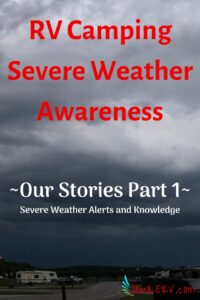
Please take the time to learn the Weather Alerts and be prepared to take shelter if needed! Stay Safe while RV Camping in Severe Weather!
RV Camping: RV Camping Different Seasons (Including Safety) Articles you don’t want to miss on SOWLERV.com!
RV Camping Severe Weather Awareness Part 1
RV Camping Severe Weather Awareness Part 2
RV Camping Severe Weather Awareness Part 3
RV Camping Severe Weather Awareness Part 4
Related Articles
7 Reasons Why THIS is the Best Portable Barbecue Grill for RV Camping!
7 Reasons Why THIS is the Best Portable Barbecue Grill for RV Camping! We needed to purchase a new Portable BBQ Grill to use with our Motorhome for when we get to go RV Camping again. We researched MANY barbecue grills trying to find the best barbecue grill for RV...
The 12 Important Steps for Towing an RV Safely [Bonus Important Safety Tips for Towing a Boat with a Truck Camper and How to Back Up an RV Trailer]
Hey everybody, Mark here along with Angie to tell you about The 12 Important Steps for Towing an RV Safely with 2 Bonuses of Important Safety Tips for Towing a Boat with a Truck Camper and How to Back up an RV Trailer! Understanding and following these safety tips...
How to Easily Change Out the Door Lock on an RV
How to Easily Change Out the Door Lock on an RV As part of the SOWLE RV series "What You Need to Know NOW to be a Safe RVer", this is also part of our Maintenance and Safety series, and we are going to show you How to Easily Change Out the Door Lock on an RV. We are...


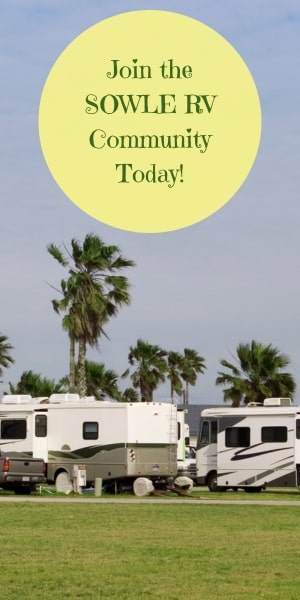

![The 12 Important Steps for Towing an RV Safely [Bonus Important Safety Tips for Towing a Boat with a Truck Camper and How to Back Up an RV Trailer]](https://sowlerv.com/wp-content/uploads/2024/03/How-to-pull-an-RV-Trailer-SOWLE-RV-min-400x250.jpg)

